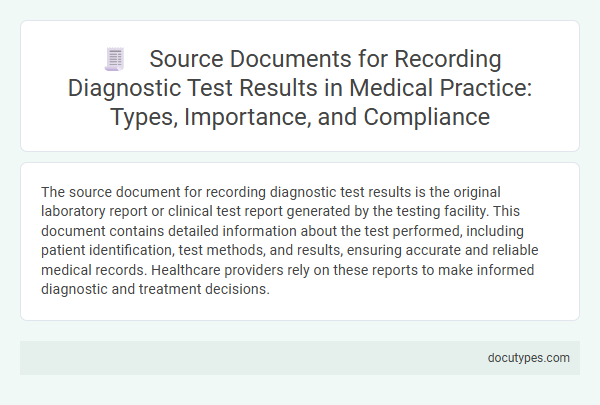The source document for recording diagnostic test results is the original laboratory report or clinical test report generated by the testing facility. This document contains detailed information about the test performed, including patient identification, test methods, and results, ensuring accurate and reliable medical records. Healthcare providers rely on these reports to make informed diagnostic and treatment decisions.
Introduction to Source Documents in Medical Diagnostics
Source documents in medical diagnostics are the original records where diagnostic test results are first documented. These documents serve as the foundation for accurate clinical decision-making and patient care.
- Source Document Definition - The primary record that captures raw data from diagnostic tests, such as lab reports or imaging results.
- Importance in Patient Care - Ensures the accuracy and reliability of medical information used by healthcare professionals.
- Regulatory Compliance - Source documents must meet legal and clinical standards for documentation and traceability.
Your clinical evaluations rely heavily on the integrity of these source documents to guide diagnosis and treatment effectively.
Types of Source Documents Used for Diagnostic Test Results
What is the source document for recording diagnostic test results? Source documents for diagnostic test results are original records that capture the findings directly from the testing process. These documents serve as the primary reference for accurate and reliable patient data.
What types of source documents are used for diagnostic test results? Common types include laboratory reports, imaging reports, and pathology reports. These documents detail test methods, results, and interpretations critical for clinical decision-making.
Paper-Based vs. Electronic Source Documents
The source document for recording diagnostic test results serves as the original record containing patient information and test outcomes. Paper-based source documents include printed lab reports, handwritten notes, and physical forms, while electronic source documents are digital records maintained in electronic health records (EHR) systems or laboratory information systems (LIS). Understanding the differences helps you ensure accuracy, accessibility, and compliance in managing diagnostic data.
Key Information Captured in Diagnostic Source Documents
Source documents for recording diagnostic test results are original medical records that capture clinical findings and laboratory data. These documents provide accurate and detailed information essential for patient diagnosis and treatment planning.
- Test Identification - Includes the name and type of diagnostic test performed to ensure precise data tracking.
- Patient Information - Contains key patient identifiers such as name, medical record number, and date of birth to link results accurately.
- Results and Observations - Documents quantitative and qualitative findings, including measurements, interpretations, and reference ranges for clinical assessment.
Legal and Regulatory Requirements for Source Documentation
The source document for recording diagnostic test results serves as the original record containing patient information and test data. It is crucial for ensuring accuracy and traceability in medical records.
Legal and regulatory requirements mandate that source documentation be complete, legible, and maintained securely to support clinical decisions and audits. Your compliance with these standards protects patient safety and upholds data integrity in healthcare settings.
Importance of Accurate Source Document Recording
| Topic | Details |
|---|---|
| Source Document for Recording Diagnostic Test Results | The source document for diagnostic test results refers to the original record or report generated by the laboratory, imaging center, or medical facility where the test was conducted. This document includes detailed information such as patient identification, test performed, specimen details, test outcomes, date and time of testing, and the name of the healthcare professional who authorized or interpreted the results. |
| Importance of Accurate Source Document Recording | Accurate recording of diagnostic test results in the source document is crucial for patient care and medical decision-making. It ensures the integrity and reliability of clinical data, which helps avoid misdiagnosis, inappropriate treatments, and medical errors. Correct documentation supports seamless communication among healthcare providers, enabling continuity of care and adherence to regulatory and legal standards. Your precise recording also facilitates auditing, research, and quality assurance initiatives within medical practice. |
Role of Source Documents in Ensuring Data Integrity
Source documents are original records where diagnostic test results are first captured, serving as the primary reference for patient data. They include lab reports, imaging printouts, and clinical notes, ensuring authenticity and accuracy in medical documentation.
These documents play a crucial role in maintaining data integrity by providing verifiable evidence of test results directly from the testing process. Accurate source documents enable healthcare professionals to make informed decisions and support reliable patient care. Proper handling and storage of source documents help prevent data loss or manipulation, reinforcing trust in clinical data.
Compliance Standards for Diagnostic Test Documentation
The source document for recording diagnostic test results is typically the original laboratory report or imaging study report provided by the testing facility. These documents serve as the authoritative record of the test findings and interpretations.
Compliance standards for diagnostic test documentation mandate accuracy, completeness, and timely entry into the patient's medical record. Regulatory bodies such as HIPAA and The Joint Commission require that diagnostic results be securely stored and accessible for clinical review and auditing purposes.
Common Challenges in Managing Diagnostic Source Documents
The source document for recording diagnostic test results is the original record generated during the diagnostic procedure, such as lab reports, imaging films, or electronic health records. Managing these documents accurately ensures reliable patient diagnosis and treatment.
Common challenges in managing diagnostic source documents include inconsistent documentation, data fragmentation, and accessibility issues.
- Inconsistent Documentation - Variability in formats and incomplete information can lead to errors and misinterpretation of diagnostic results.
- Data Fragmentation - Source documents often exist across multiple systems, making it difficult to obtain a comprehensive view of patient diagnostics.
- Accessibility Issues - Restrictions or delays in accessing source documents hinder timely clinical decisions and affect patient care quality.
What Is the Source Document for Recording Diagnostic Test Results? Infographic

